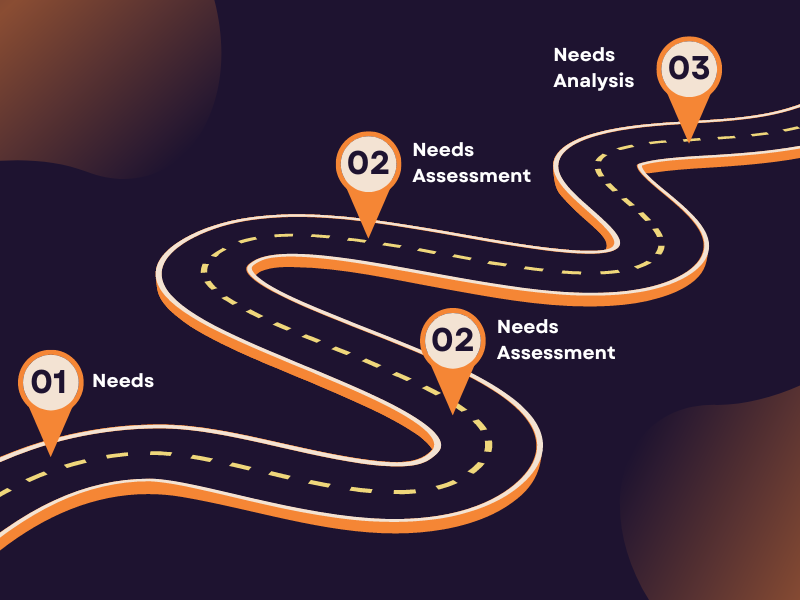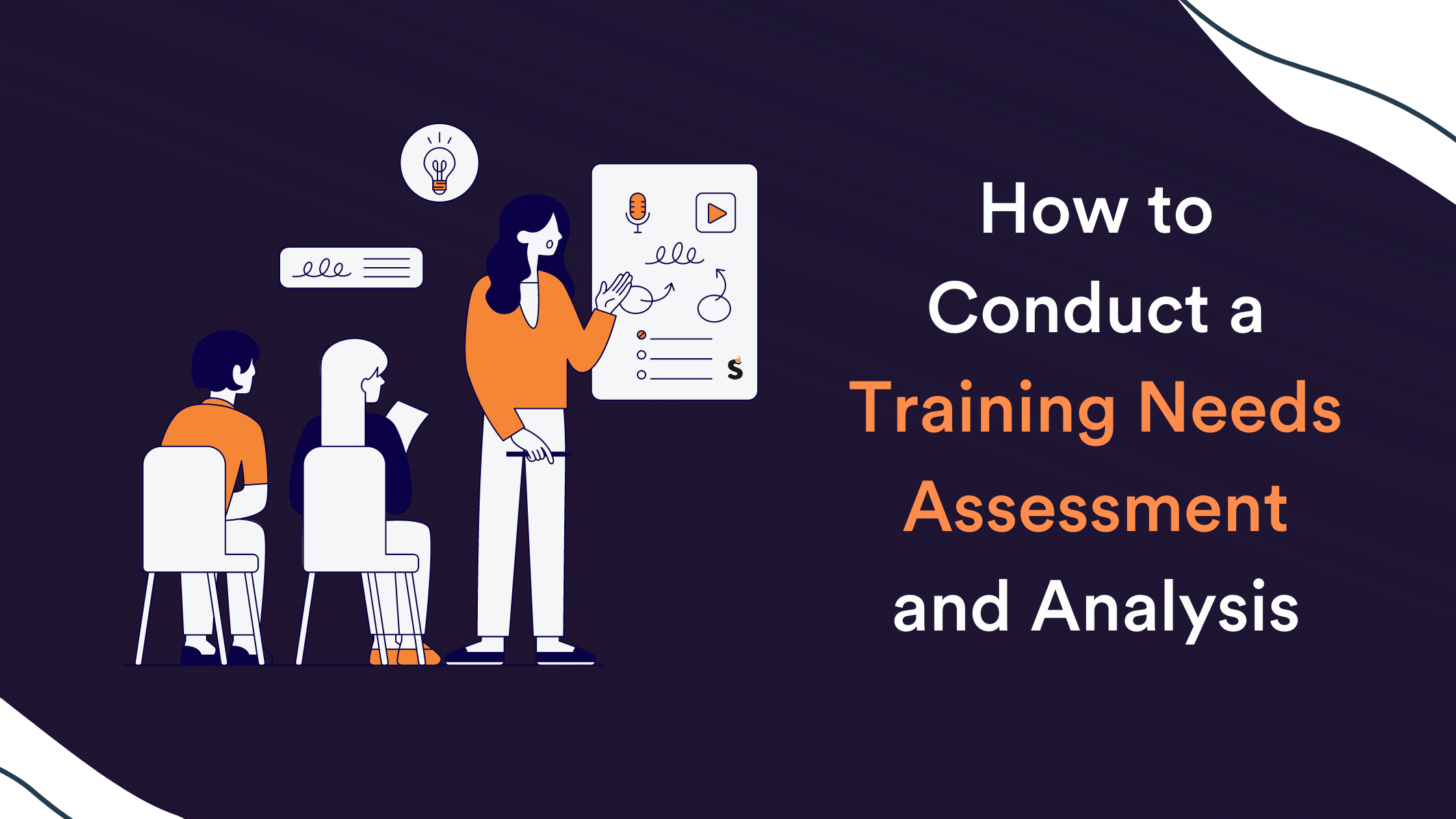When your business is growing fast and onboarding lots of new talent, recent hires can get out of the loop — and any company can fall prey to bottlenecks that hold employees back from reaching their full potential. Training and online courses are common solutions, but are they right for you? This is the question a training needs assessment and analysis aims to answer.
We’ll run through how a training needs assessment works and the steps involved in conducting an analysis. Even though “training needs assessment and analysis” is a common first step in the training development process and used by instructional designers, any business owner or entrepreneur can use this framework to understand if and what training program is required to achieve a business goal.
What is a Training Needs Assessment and Analysis?
Now let’s break down both concepts:
- A training needs assessment is an exercise that determines whether an organization has a need (defined as an area where performance isn’t as high as it could be).
- Needs analysis goes one step further by examining the root causes of underperformance, and looking for solutions to help an organization close the gap. Each “need” is broken down into more detailed components to understand the best ways to address them.

By conducting a thorough analysis, organizations can prioritize training efforts, allocate resources more efficiently, and design training programs that are tailored to meet the unique needs of their workforce. This ensures that training is not just an arbitrary or one-size-fits-all solution, but a strategic tool that contributes directly to the organization’s goals and improves overall performance.
Why Use a Training Needs Assessment?
The average large company in the US had a training expenditure of $19.2 million in 2022, and the country’s total spending over $100 billion in the same year. That’s too much money to spend on training that doesn’t get results.
| Organization Type | Large | Midsize | Small | Average |
|---|---|---|---|---|
| Education | $1,285,714 | $1,680,000 | $103,333 | $1,069,000 |
| Government/Military | $98,420,000 | $1,643,774 | $410,821 | $14,860,700 |
| Manufacturer/Distributor | $8,047,264 | $1,211,538 | $389,917 | $3,528,449 |
| Non-profit | $1,037,500 | $648,636 | $214,300 | $537,120 |
| Association | $8,900,000 | $875,000 | $100,000 | $2,687,500 |
| Retail/Wholesale | $5,000,000 | $2,238,778 | $519,033 | $2,054,315 |
| Services | $15,032,500 | $1,491,489 | $413,716 | $3,418,755 |
| Avg. Across Sizes | $19,239,425 | $1,473,427 | $368,891 | $4,806,664 |
It’s crucial to ensure that any investment will tackle the root cause of a company’s issues and achieve real results.
How to Carry out a Training Needs Assessment
Essentially, training needs assessment boils down to the following four steps:
- Analysis
- Goal-setting
- Root cause analysis
- Solution-finding
We’ll run through each one.
1. Analysis
First, you need to understand your organization’s current situation. This is all about diagnosing the problem and understanding the complete picture.
Information you gather may include:
- Whether current processes match desired processes
- Performance of employees
- Whether the firm is achieving its objectives
Observing the company’s processes and performances firsthand will provide some of this information. For instance, you might watch how a sales representative conducts a sales call and compare this to a maximum-performance approach.
You should complement this with firsthand accounts from employees (such as surveys or interviews) to gather their views on how things are going and what could be improved.
2. Goal-Setting
Once you understand how things stand today, you can move on to setting goals about what you need to change. These should focus on the issues identified in the stage above and align with the company’s interests, aiming to improve revenue in some way.
Since needs are the gap between current and optimum performance, closing this gap through training should have verifiable results.
Examples of goals could be:
- Improved customer service
- Employees completing a process more quickly
- Avoidance of common errors that hurt performance
By setting a goal early on, you can later assess whether training was an effective solution by seeing what return on investment it achieved.
3. Root Cause Analysis
It’s easy to wave “education” or “training” as some magic bullet that will solve any problem a company faces. However, there are times when there may be another explanation as to why employees are underperforming or a company isn’t achieving what it wants.
Root cause analysis tries to cut through the noise to find out what’s really going on instead of assuming training will always be the answer. There may be a simpler and more cost-effective alternative — or you may want to take a two-pronged approach by using training alongside other solutions.
Some examples of true root causes of problems may be:
- Poor management
- Corporate culture issues
- Inefficient processes
- A lack of communication
- Issues with software
It’s not always immediately apparent what the true root cause is, but it helps to determine whether a performance gap is due to a lack of skills and knowledge or if one of the above factors is playing a role.
You may want to talk to employees, managers, and anyone else involved to ascertain why they think the failure is happening.
4. Solution-Finding
Now you have a clear idea of your goal and why you have a performance gap in the first place, you can finally turn your attention to finding a solution.
Given you’re carrying out a training needs assessment, you likely have some idea that you want to use training or elearning as a solution, but try to approach this stage with an open mind in case there’s an alternative you could pursue. For instance, it might be a better option to choose new software or add (or remove) processes to make them easier for employees to follow.
Here’s how to approach different areas:
- Motivation — is it due to a lack of knowledge and skills or the environment?
- Skills — most likely need training
- Knowledge — may be solved through a job aid
- Cultural issues — may be tough to change through training
- Other environmental issues — training can help but may need other solutions too
Occasionally, you might also decide that a training program wouldn’t yield enough benefits to pursue at all.
If you do decide that training is the right choice for you, great — you can start designing a curriculum to get your team up to speed. Often, organizations work with a third party to get this off the ground and develop a tailored learning experience rather than trying to handle everything internally.
Next Steps
Performance gaps can be a slow killer of business, so it’s crucial to be proactive about identifying and closing these gaps as quickly as possible. However, before developing any training, it is essential to conduct a training needs assessment to secure the best possible ROI. SkildLabs works with organizations to help them develop effective learning experiences, and assessing where a company is today is always our first step. If you’re interested in seeing how this could work for you, contact us for a resource review.
